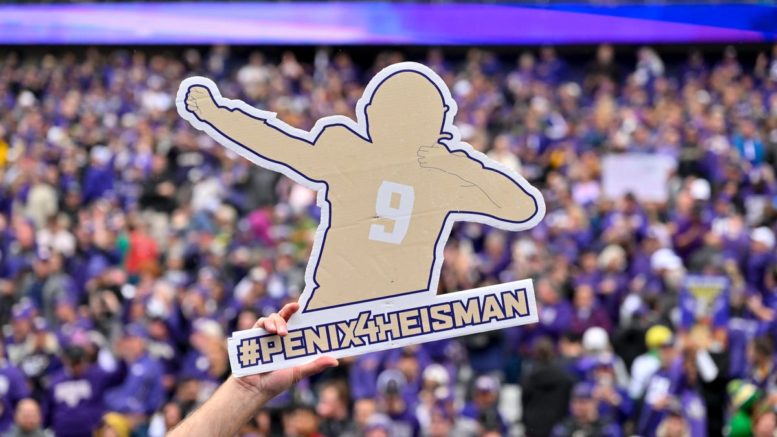You know progress is taking place when things that used to be groundbreaking become the norm. Thankfully, it’s been a long time since Andre Ware was the only one.
With the announcement of this year’s class of Heisman Trophy finalists, it means that 27 quarterbacks have been invited to New York since 2013. But, most importantly, it means that since 2013, 16 quarterbacks of color have been named finalists — 45.7 percent.
Oregon’s Bo Nix, LSU’s Jayden Daniels, Ohio State’s Marvin Harrison Jr., and Washington’s Michael Penix Jr., will all be vying to take home the most prestigious award in college sports on Saturday — three quarterbacks and a wide receiver. If Daniels — who many consider the favorite — or Penix Jr. wins, they would become the seventh quarterback of color to win it since 2013. In that same time frame, 27 finalists in all have been quarterbacks, as it’s proof that it’s almost impossible to win it if you play running back or wide receiver. Unless you’re DeVonta Smith, who won the award in 2020, making him the first receiver to have that honor since Desmond Howard in 1991.
So, despite how a lot of us might think that Harrison Jr. is the best player not in the NFL, his chances of winning the award are slim, given that 77 percent of the finalists since 2013 have been the guys who throw the ball, not the ones who catch them.
Like the MVP award in the NFL, the Heisman has been something that voters almost exclusively give to quarterbacks. And in the same way that the face of the quarterback is changing in the pros, it’s even more apparent in the college ranks.
“As I’ve gotten older, it means a little more,” Andre Ware said back in 2014. “When you’re the first to accomplish anything, you take pride in it.” When the former Houston Cougar won the Heisman back in 1989, he became the first Black quarterback to ever receive the honor.
“To be honest, going through the process that year, it never really occurred to me,” Ware told ESPN in the past. Ware walked in the footsteps of Syracuse’s Ernie Davis, the first Black player to win the Heisman in 1961. In terms of quarterbacks, Florida State’s Charlie Ward came after Ware, and then there was Ohio State’s Troy Smith, and so on and so on.
In 2014, more history was made when Oregon’s Marcus Mariota became the first Polynesian and Hawaiian to win the award. The tanning of the Heisman had become a real thing.
“I hope and pray that this is only the beginning,” Mariota said to his fellow Polynesians when he won the award.
“To young Poly athletes everywhere, you should take this as motivation and dream big and strive for greatness.”
It would be weird if I didn’t acknowledge that the Heisman Trophy has lost a lot of its luster over the past years. The domination of quarterbacks, the lack of defensive players being considered and team success have played a part in many of us feeling like the award doesn’t truly go to the “most outstanding player in college football.” And while that may be true, it doesn’t take away how impactful the award still is in sports and culture, and how much you can tell has changed within sports and culture by who keeps getting invited to New York City.
Original source here
#percent #Heisman #finalists #QBs #color #progress





